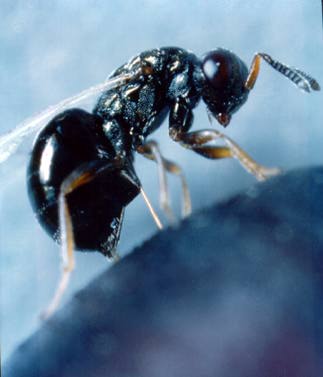 |
|
Nasonia
vitripennis female ovipositing in a fly pupa. |
The genetic changes associated with speciation in animals is poorly understood. Outside of Drosophila, very few studies of the genetic basis of premating and postmating isolation have been conducted, and next to nothing is known about the genetics of speciation in haplodiploid organisms. Several years ago, I discovered two sibling species of N. vitripennis (NV) in North America, N. longicornis (NL) occurs in the west, and N. giraulti (NG) occurs in the east, and these were characterized in collaboration with the hymenopteran taxonomist C. Darling (Darling and Werren 1990). NG and NL are allopatric, but both are sympatric with the cosmopolitan NV. The three species are closely related with estimated divergence times between NL and NG, and between the pair and NV of 100,000 and 200,000 years respectively, based upon sequence divergence of ribosomal gene spacers (Campbell et al 1994) and mitochondrial 16S (Reed and Werren, unpub. data).
I believe this species complex is ideal for evolutionary genetic research because genetic mutants are available for linkage studies, hybrids are fertile, and a number of interesting genetic differences occur between the species that are tractable for genetic analysis. Hybrids between NV and NG are typically prevented by cytoplasmic incompatibility Wolbachia. I am currently determining whether there is strain variation in the degree of bacterial induced reproductive isolation. Removal of the microbes by antibiotic treatment results in production of fertile hybrids. This allows the study of genetic differences between these closely related species. An especially useful feature of this system is that F1 females can be set as virgins, yielding F2 males that are homozygous for either an NV or NG allele at each locus. This greatly facilitates analysis of interactions between genes of the two species, without the further complexity of dominance. In addition, because hybrid lethality is not complete and hybrids are fertile, backcross and introgression experiments can be performed for detailed genetic analysis of this system.
So far, we have uncovered three interesting "speciation genes" that are tractable for study, (1) an interacting set of two or more recessive nuclear hybrid lethal genes (2) a recessive nuclear gene (or genes) in V that interacts with a G cytoplasmic factor (presumably mitochondrial) to cause hybrid lethality, and (3) a single gene of major effect (plus modifiers) responsible for a clear cut morphological difference between the species (male wing size). Here we are using "gene" in the general sense to denote a region that segregates in a mendelian fashion. We have not resolved whether the traits are due to single genes, versus a set of tightly linked cosegregating genes affecting the same trait.
Plans are to map the sets of interaction hybrid lethal genes with visible and molecular markers, followed by more detailed developmental and cytological studies of causes of hybrid mortality. We have already mapped one hybrid lethal gene to within 1-2 map units of a visible marker, greatly facilitating these studies. In addition, mapping of molecular markers will aid in the rapid identification of genes involved in both morphological and behavioral differences between these closely related species. Such studies are facilitated by the haplodiploid genetics of this organism. This work will set the stage for an extensive analysis of the genetic and phenotypic changes associated with speciation in a group of closely related species.
Selected Publications
(click here to get pdf files for some of the papers below)
Opijnen, T., E. Baudry, J. Bartos, L. Baldo, and J.H. Werren. Genetic variability in the three genomes of Nasonia: Nuclear, mitochondrial and Wolbachia. Insect Molecular Biology (In Press).
Velthuis, B.J., W. Yang, T. van Opijnen and J.H. Werren. 2004. Intra-specific variation in sexual isolation: Genetics of female mate discrimination in Nasonia longicornis (Darling) (Hymenoptera, Pteromalidae). Animal Behavior 69:1107-1120.
Bordenstein, S.R., M. Drapeau and J.H. Werren. 2000. Intraspecific variation in interspecific premating isolation between two Nasonia species. Evolution 54: 567-573.
Gadau, J., R. Page and J.H. Werren. 1999. Mapping of hybrid incompatibility loci in Nasonia. Genetics 153:1731-1741.
Weston, R., I. Qureshi and J.H. Werren. 1999. Genetics of a morphological difference between two insect species. Journal of Evolutionary Biology 12:586-595.
Werren, J.H. and M.J. Perrot-Minnot. 1999. An antennapedia mutant in Nasonia vitripennis. J. Heredity 90:319-320.
Drapeau, M. and J.H. Werren. 1999. Differences in mating behavior and sex ratio between three sibling species of Nasonia. Evolutionary Ecology Research 1:223-234.
Werren, J.H. 1998. Wolbachia and speciation. in Endless Forms: Species and Speciation, (D. Howard and S Berlocher, eds). pp. 245-260. Oxford University Press.
Breeuwer, J.A.J. and J.H. Werren. 1995. Hybrid breakdown between two haplodiploid species: The role of nuclear and cytoplasmic genes. Evolution 49:705-717.
Assem, J. van den and J.H. Werren. 1994. A comparison of the courtship and mating behavior of three species of Nasonia (Hym., Pteromalidae). J. Insect Behav. 7:53-66.
Campbell, B.C., J.D. Steffen-Campbell and J.H. Werren 1993. Phylogeny of the Nasonia species complex (Hymenoptera: Pteromalidae) inferred from an rDNA internal transcribed spacer (ITS2). Insect Molec. Biol. 2:255-237.
Breeuwer, H. and J. H. Werren. 1990. Microorganisms associated with chromosome destruction and reproductive isolation between two insect species. Nature 346: 558-560.
Darling, D.C. and J.H. Werren. 1990. Biosystematics of two new species of Nasonia Hymenoptera: Pteromalidae) reared from birds' nests in North America. Annals Ent. Soc.Amer. 83(3):352-370.